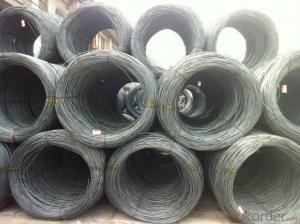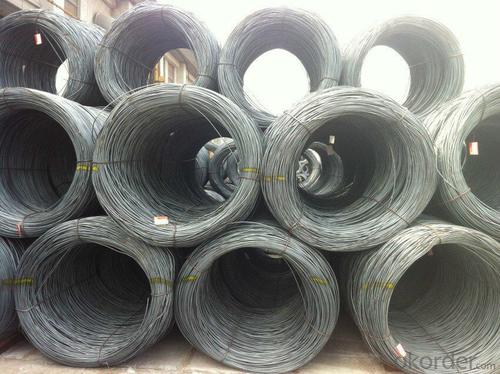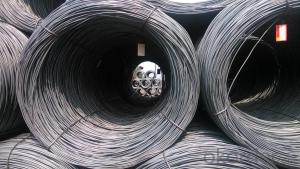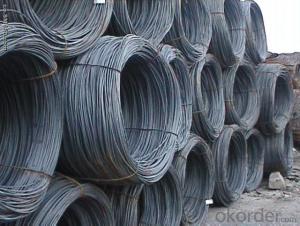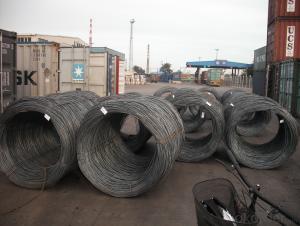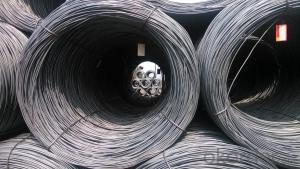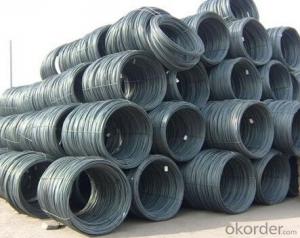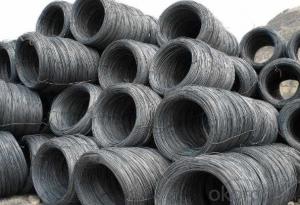wholesale carbon hot rolled steel wire rod in coil with lower price
- Loading Port:
- Tianjin
- Payment Terms:
- TT OR LC
- Min Order Qty:
- 25 m.t.
- Supply Capability:
- 5000 m.t./month
OKorder Service Pledge
OKorder Financial Service
You Might Also Like
Specification
Specifications of Steel Wire Rod in Coil:
Steel Grade: Q195/235, SAE1006-1018B Standard: ASTM, GB
Diameter: 5.5mm, 6.5mm, 7mm,8mm,9mm,10mm,12mm,14mm
Type: Drawn Wire Alloy or Not: Alloy Brand Name: HSKY
Technique: Hot Rolled Place of Origin: China Mainland
Chemical Composition:(Please kindly find our chemistry of our material based on SAE1006B and SAE1008B as below for your information)
High carbon/Low carbon/common carbon Steel wire rod | With boron for rebate tax |
Grade | SAE1006B SAE1008B SAE1018B |
Package | In coil ,in bundle, |
Coil weight | about 2000kg-3000kgs |
Size: | 5.5mm 6.5mm 8mm 10mm 12mm 14mm 16mm |
Types | High Carbon ,Low carbon ,Common carbon |
Exported Country | South Korea,Vietnam,Indonesia,Myanmar,Philippines and Afrca,Ect |
Delivery term: | within 30 days after receive the LC |
Payment Term: | LC at sight ,LC 30-120 days after B/L date, TT payment |
The Standard of Physical Properties:
Grade | Chemical Composition(%) | |||||
C | Mn | Si | S | P | Cr | |
SAE1006 | 0.03~O.07 | ≤0.32 | ≤0.30 | ≤0.045 | ≤0.040 | >0.30 |
Mechanical properties | ||||||
Yield strength(N/mm2) | Tensile strength(N/mm2) | Elongation(%) | ||||
250-280 | 350-380 | ≥32 | ||||
Grade | Chemical Composition(%) | |||||
C | Mn | Si | S | P | Cr | |
SAE1008 | 0.10max | 0.3~O.50 | 0.15max | 0.050max | 0.040 max | 0.30 min |
Mechanical properties | ||||||
Yield strength(N/mm2) | Tensile strength(N/mm2) | Elongation(%) | ||||
≥195 | 315-430 | ≥30 | ||||
Usage and Applications of Steel Wire Rod in Coil:
After hot-rolled the products shaped into coil and delivery as finished product, including round, square, rectangular, hexagonal and so on, Since most of the products are round, it is generally called wire rod. Steel wire rod is widely used in construction and manufacturing. Steel wire rod is mainly used for reinforcement of reinforced concrete and welded structure or reprocessed (roberts, nail etc) materials, especially used to produce wire drawing, welding electrode, nails,spring, electronic, precise machinery parts and so on.
Packaging & Delivery of Steel Wire Rod in Coil:
Packaging Detail: products are packed in coil and then shipped by container or bulk vessel
Each coil weight: 2-3MT
Delivery Detail: within 45 days after received deposit or LC.
Label: to be specified by customer, generally, each bundle has 1-2 labels
Trade terms: CFR, CIF
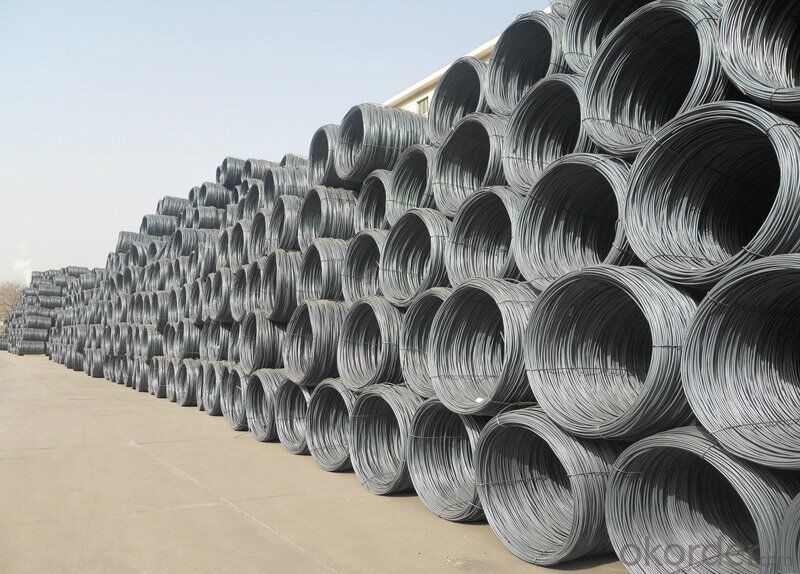
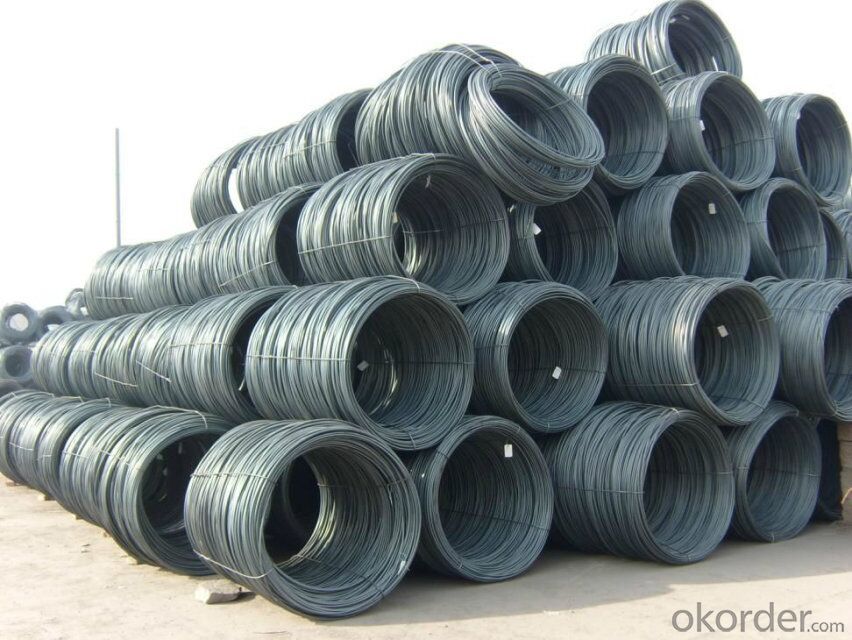
- Q: How is steel wire rod stored and handled to prevent damage?
- To maintain the quality and performance of steel wire rod, it is necessary to handle and store it carefully. Several measures are commonly taken to ensure the integrity of the wire rod. To begin with, a designated area that is clean, dry, and well-ventilated is used for storing steel wire rod. This helps to minimize the risk of moisture exposure, which can lead to corrosion and rusting. Additionally, the storage area should be kept away from potential sources of damage such as heavy machinery, sharp objects, or chemicals that can cause surface abrasions or chemical reactions. To prevent physical damage, steel wire rod is often placed on pallets or racks to keep it off the ground and protect it from impacts or contamination. The stacking height should be limited to avoid excessive pressure on the lower layers, which can cause deformation or breakage. Moreover, steel wire rod is typically bundled or coiled to provide extra protection during storage and transportation. Bundling helps to maintain the shape and integrity of the wire rod, preventing bending or warping. Coiling is commonly used for longer lengths of wire rod and offers better handling and storage options. Proper training in safe lifting and transportation techniques is essential for personnel handling steel wire rod to prevent accidents that could damage it. The use of suitable lifting equipment, such as cranes or forklifts, is recommended to minimize the risk of dropping or mishandling the wire rod. Regular inspections should also be carried out to identify and address any signs of damage or deterioration, such as surface rust, dents, or deformations. Any damaged wire rod should be promptly removed from storage and replaced to prevent further deterioration or potential safety hazards. By following these storage and handling practices, the quality and performance of steel wire rod can be effectively preserved throughout its lifespan.
- Q: What are the main challenges in manufacturing steel wire rod?
- Manufacturing steel wire rod presents several primary challenges. Consistent quality and uniformity in production prove to be one of these challenges. This necessitates strict control over the steel's chemical composition and mechanical properties, as any deviation can impact the final product's performance and reliability. Consequently, adherence to quality control procedures and continuous monitoring throughout the manufacturing process become essential. Another hurdle is achieving the desired dimensional accuracy and surface finish of the wire rod. This requires precise regulation of temperature and speed during the rolling process to ensure proper shape and size. Any irregularities or defects in the wire rod can compromise its strength and durability, rendering it unsuitable for intended applications. Balancing high production rates with safety and minimizing downtime also poses a significant challenge. Complex machinery and equipment used in steel wire rod manufacturing necessitate regular maintenance and monitoring to prevent breakdowns. Additionally, ensuring worker safety in this environment requires the implementation of strict safety protocols and the provision of appropriate safety equipment. Environmental sustainability is yet another challenge in steel wire rod manufacturing. The production process consumes substantial energy and emits greenhouse gases. To reduce the industry's environmental impact, energy-efficient technologies must be implemented, waste materials should be recycled and reused, and sustainable practices adopted throughout the entire production chain. Moreover, the steel wire rod industry faces the challenge of increasing competition and fluctuating market demands. Manufacturers must remain up-to-date with market trends, adapt to changing customer requirements, and constantly innovate to stay competitive. This involves investing in research and development to enhance product quality, develop new alloys, and explore alternative manufacturing methods. In conclusion, addressing challenges related to quality control, dimensional accuracy, safety, environmental sustainability, and market competitiveness is crucial in manufacturing steel wire rod. Overcoming these challenges requires a combination of advanced technology, a skilled workforce, and continuous improvements in manufacturing processes.
- Q: How is steel wire rod used in construction?
- Steel wire rod is commonly used in construction for a variety of purposes. It is primarily used as reinforcement in concrete structures such as foundations, columns, beams, and slabs. The wire rod is often embedded within the concrete to increase its tensile strength, making the structure more durable and resistant to cracking or collapsing under heavy loads. Additionally, steel wire rod is used for tying and securing materials together, such as reinforcing bars and formwork, during the construction process. Overall, steel wire rod plays a crucial role in enhancing the structural integrity and safety of various construction projects.
- Q: How is steel wire rod used in the production of suspension springs?
- Steel wire rod is used in the production of suspension springs as it provides the necessary strength and flexibility required for these components. The wire rod is typically formed into a coil shape and then undergoes various processes such as heat treatment and cold forming to achieve the desired spring characteristics. This steel wire rod is commonly used due to its ability to withstand heavy loads and maintain its shape, ensuring optimal functionality and durability of suspension springs.
- Q: What are the different sizes and diameters available for steel wire rod?
- Different sizes and diameters of steel wire rods are available to cater to various applications and industries. The range of sizes typically falls between 5.5mm and 20mm, with common sizes including 6mm, 8mm, 10mm, 12mm, and 16mm. The diameter of a steel wire rod determines its strength and load-bearing capacity, referring to its thickness or width. The required diameter depends on the intended use of the wire rod. Heavy-duty applications, such as construction, often require thicker diameters, while lighter applications like fencing or wire mesh can use thinner diameters. To meet the diverse needs of industries like construction, automotive, manufacturing, and agriculture, manufacturers produce steel wire rods with various diameters. Customers can choose the appropriate size and diameter based on the specific requirements of their project or application to ensure optimal performance and durability.
- Q: What are the main competitors in the steel wire rod market?
- The main competitors in the steel wire rod market include companies like ArcelorMittal, Nippon Steel Corporation, Tata Steel, Gerdau, and POSCO.
- Q: What are the main factors influencing the choice of steel wire rod warranty?
- The main factors influencing the choice of steel wire rod warranty include the quality and reliability of the product, the reputation and trustworthiness of the manufacturer, the terms and conditions of the warranty, the length of the warranty period, and the level of customer support provided by the manufacturer.
- Q: What are the different types of finishes available for steel wire rod?
- There are several different types of finishes available for steel wire rod, each serving a specific purpose and providing unique properties. 1. Bright Finish: This is the most basic and common finish for steel wire rod. It is achieved by removing any scale or rust from the surface of the rod, resulting in a shiny and smooth appearance. Bright finish is often used for applications where aesthetics are important, such as decorative purposes or in products that are visible to consumers. 2. Galvanized Finish: Galvanizing is a process of applying a protective zinc coating to the surface of the steel wire rod. This finish provides excellent corrosion resistance and is commonly used in outdoor applications or environments with high moisture or humidity. It also offers some degree of abrasion resistance, making it suitable for certain industrial applications. 3. Phosphate Finish: Phosphating is a chemical process that creates a thin layer of phosphate coating on the surface of the steel wire rod. This finish enhances the adhesion of lubricants or coatings, improving the wire's performance in applications where lubrication or corrosion resistance is critical. Phosphate finishes are commonly used in automotive and manufacturing industries. 4. Coated Finish: Steel wire rod can be coated with various materials to provide specific properties. For example, epoxy coatings offer excellent corrosion resistance and are often used in marine or chemical environments. Polymer coatings can provide abrasion resistance, electrical insulation, or improved adhesion properties. Coated finishes are typically tailored to meet specific application requirements. 5. Black Oxide Finish: Also known as blackening, this finish is achieved by converting the surface layer of steel wire rod into a black iron oxide compound. Black oxide finishes provide mild corrosion resistance and improve the wire's appearance. They are commonly used in applications where a black or darkened finish is desired, such as in architectural or decorative products. 6. Zinc-Nickel Finish: This finish is a combination of zinc and nickel plating, providing enhanced corrosion resistance compared to traditional galvanized finishes. Zinc-nickel coatings are commonly used in automotive and aerospace industries, where high corrosion resistance is required. These are just a few examples of the different types of finishes available for steel wire rod. The choice of finish depends on the intended application and the specific properties required, such as corrosion resistance, abrasion resistance, or aesthetics.
- Q: How are steel wire rods used in the manufacturing of screws and bolts?
- Steel wire rods are an integral component in the manufacturing of screws and bolts. These wire rods serve as the raw material from which the screws and bolts are formed. The manufacturing process begins with the selection of high-quality steel wire rods that possess the desired strength and durability characteristics needed for screws and bolts. These wire rods are then subjected to various processes such as heating, rolling, and drawing to transform them into thinner wire forms with precise dimensions. The drawn wire is then further processed through a series of steps to create the specific shape and thread pattern required for screws and bolts. For instance, the wire may be cut into shorter lengths, and the ends are typically chamfered or beveled to allow for easier insertion into materials. Once the wire has been shaped and prepared, it undergoes a threading process. This involves the creation of helical ridges on the wire, which will later enable the screw or bolt to securely fasten objects together. The threading can be done using different methods, such as rolling, cutting, or grinding, depending on the desired type of screw or bolt. After the threading process, the wire is cut into individual pieces of the desired length, and the heads of screws or bolts are formed using various techniques like cold forging or hot forging. Cold forging involves shaping the head by applying pressure to the cold wire, while hot forging involves heating the wire before shaping it. Following the formation of the heads, the screws and bolts are subjected to additional processes such as heat treatment, surface coating, and quality control inspections. These processes ensure that the final product meets the required strength, corrosion resistance, and dimensional accuracy standards. In summary, steel wire rods play a crucial role in the manufacturing of screws and bolts. They serve as the starting material and undergo various processes, including shaping, threading, and forming, to ultimately produce the high-quality screws and bolts that are widely used in numerous industries.
- Q: How are steel wire rods used in the manufacturing of wire baskets for storage?
- Steel wire rods are used in the manufacturing of wire baskets for storage by being shaped, cut, and welded to form the framework of the basket. These rods provide strength and durability to support the weight of items being stored, while also allowing for airflow and visibility.
Send your message to us
wholesale carbon hot rolled steel wire rod in coil with lower price
- Loading Port:
- Tianjin
- Payment Terms:
- TT OR LC
- Min Order Qty:
- 25 m.t.
- Supply Capability:
- 5000 m.t./month
OKorder Service Pledge
OKorder Financial Service
Similar products
Hot products
Hot Searches
Related keywords
